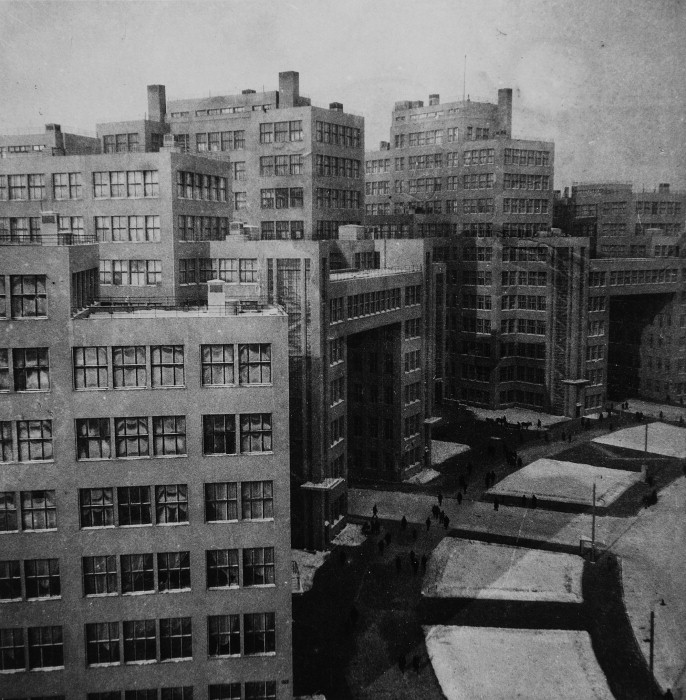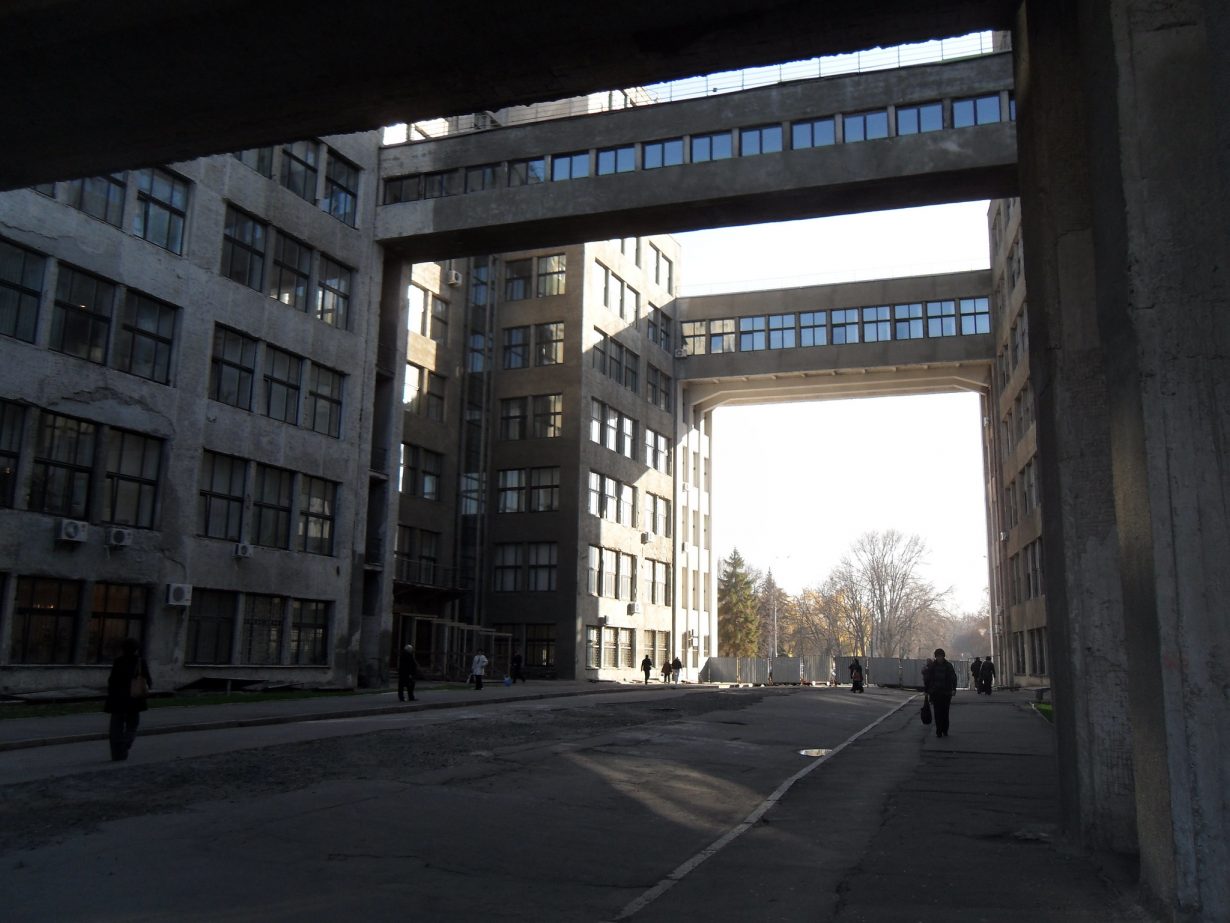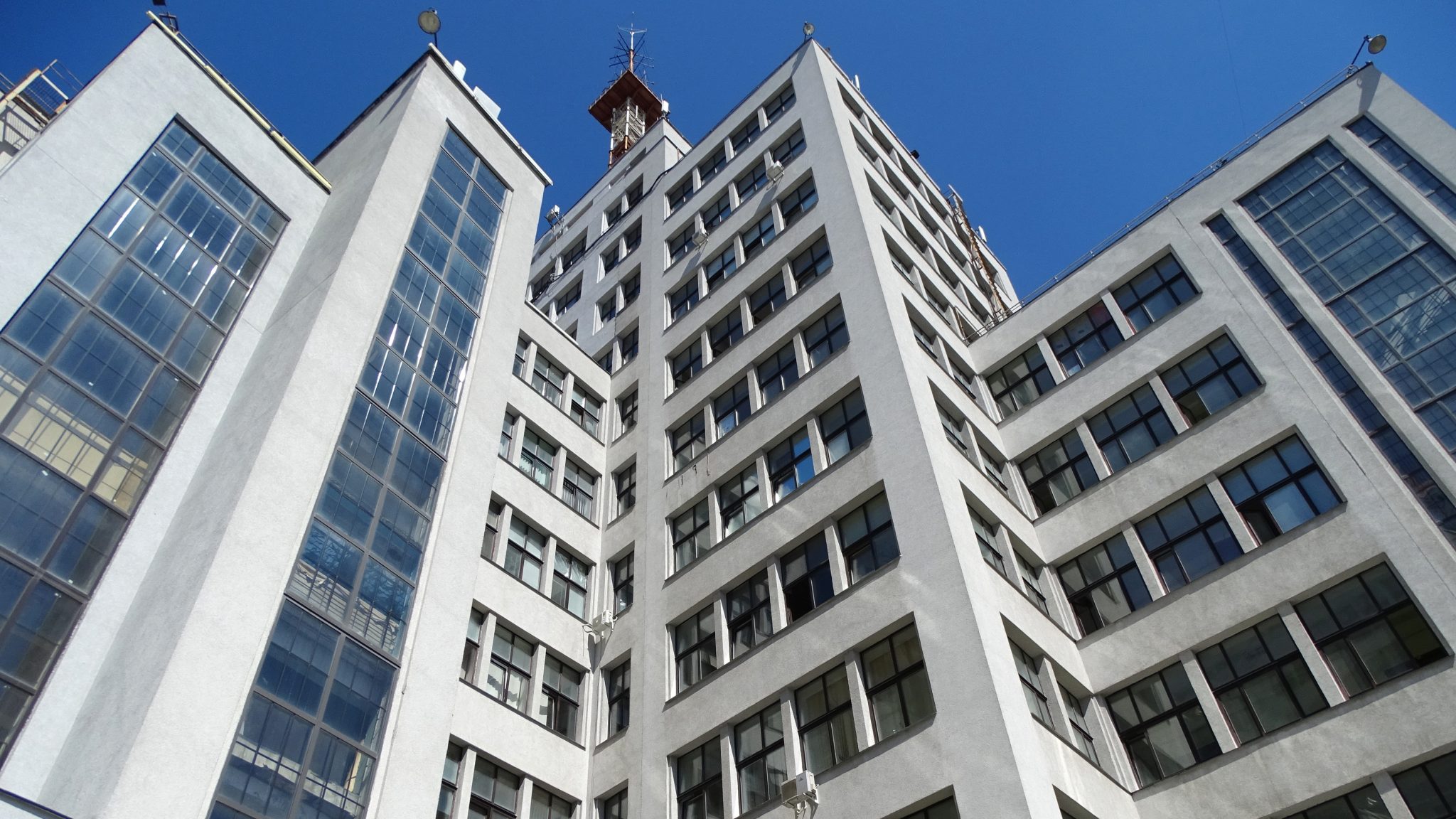Russia’s recent strike on Kharkiv’s Constructivist complex represents an attack on a radical yet largely forgotten legacy of anticolonialism
The Derzhprom building, a vast Constructivist complex in the centre of the Ukrainian second city of Kharkiv – which received a direct hit from a Russian rocket at the end of October – was on something called the UNESCO ‘tentative list’, the longlist of buildings which are considered for World Heritage Status after a proposal from a national state. In 2022 Derzhprom was pushed further up the list, but it’s doubtful even full UNESCO listing would have saved it. In contemporary warfare, historical monuments are routinely targeted by precision weaponry. In the same week Derzhprom was attacked, the Israel Defence Forces were bombing Baalbek in Lebanon, home of a UNESCO-listed Roman temple complex, and wiping Gaza City, a place of almost incalculable antiquity, off the face of the earth. This process of erasure is horribly familiar. But in the case of Derzhprom, what exactly is it that Russia is trying to erase?
Derzhprom is an extraordinary building: an office complex designed in 1925 and opened in 1928 as the headquarters of the Ukrainian Soviet Socialist Republic, framing Freedom Square in the centre of Kharkiv. It was outrageously advanced for its time – a symmetrical ensemble of concrete towers tightly bunched together into three parts, which are linked to each other by high skybridges; the building’s height (its central part, at thirteen storeys, was for a few years the tallest office building in Europe). Those vertiginous bridges mean it resembles a science fiction dream project more than a mundane office block; in its sheer aggression and drama and its fearless look into the future, it anticipated Brutalist buildings from half-a-century later, from the skybridges of the University of Leeds to the clustered towers of New Belgrade.


One corner of Derzhprom was badly damaged by the recent strike, but it survived attempts to destroy it by Ukraine’s Nazi occupiers 80 years ago, and it will outlast this war too. Yet the severe damage inflicted upon one of the great modernist buildings of the 20th century offers a moment to reflect on the incredibly rich avant-garde legacy that exists within Ukraine – and especially in Kharkiv, Ukrainian capital between 1919 and 1934. Kharkiv’s Constructivism came out of a unique combination of communism, nationalism, modernism and anticolonialism, leaving paintings, poems, sculptures and still-standing buildings that faced official anathema in the early 1930s and have been ignored in the west ever since.
Ukrainian – and Caucasian, and Central Asian – historians of art and architecture have spent much of the last two decades trying to dismantle the notion of a ‘Russian avant-garde’, the term foisted on Russian imperial and Soviet modernist movements by American scholars in the 1970s. The efforts to decentralise this history would have pleased the USSR’s founders, if not its later leaders. In the course of the Civil War that followed the Bolshevik seizure of power in October 1917, Lenin clamped down firmly on Russian nationalists within the revolutionary movement and attempted after it to create a federal state, giving each nationality full autonomy and the right of secession. This was the reason why Putin officially condemned Lenin in a rambling speech upon launching the full-scale invasion of 2022.
In culture and education, this meant Korenizatsiya, usually translated as ‘indigenisation’: education and publishing would be in the local language first and foremost, and local cadres would have preference over Russian, in an early form of affirmative action. This policy was forcibly reversed under Stalin in the early 1930s, with disastrous consequences for Ukraine, whose peasantry was starved and its socialist intelligentsia massacred. In 1934, the capital of Soviet Ukraine was moved to Kyiv, long considered by Russian nationalists as the ‘mother of Russian cities’. But Derzhprom is the great monument to the early USSR’s anti-nationalist moment.

This enormous edifice, built to a competition-winning design by the architects Sergei Serafimov, Mark Felger (both from Ukraine’s major port city, Odesa) and Samuil Kravets (from Vilnius, Lithuania) expressly as the iconic structure of Soviet Ukraine; it would be ruled and administered from here, not from Moscow. Huge as it is, Derzhprom is actually only one part of a colossal circus of concrete buildings (the others were reclad in Stalinist neoclassical style after the Second World War) that faced the specially-designed Freedom Square, then Europe’s largest. Derzhprom was a statement of futurism and collectivity, and of autonomy. There was nothing on the same scale in Russia, or anywhere else. Alongside Derzhprom, the city’s reconstruction as the capital of Ukraine saw much modernist social housing, alongside public buildings like a Constructivist telephone exchange and post office, and the almost baroque, expressionistic Palace of Culture of Railway Workers. The writers and artists who were creating this new socialist, non-Russian, Ukrainian culture were housed in the Slovo (‘Word’) building, a block of flats in the shape of the Cyrillic ‘S’. The latter two buildings were both bombed in 2022.
The politics behind this activity are debatable – some have preferred to see it as a ruse by the Bolsheviks to curry favour before switching back to Russification. But during the 1920s it was taken very seriously indeed, by Ukrainian socialists like the minister of education Mykola Skrypnyk, the ruralist painter Mykhailo Boychuk, the Constructivist designer Vasyl Yermilov, the writer and polemicist Mykola Khvylovy, the futurist Mykhailo Semenko, the film director Oleksandr Dovhzhenko, the theatre director Les Kurbas – almost all of whom were murdered or died by suicide in the 1930s. The avant-garde Kharkiv they built was intended as a showcase for western visitors, as an exemplar of development for Eastern European nations, and as proof that Russian imperialism was being eradicated in the USSR.

In that, Derzhprom was of a piece with the Bolshevik reaching-out to the colonial world, through the Congress of the Toilers of the East in Baku, the universities for Asian and African scholars and activists, and the support of revolution in China, Indonesia and India. When Moscow became more culturally conservative, Kharkiv held out, for a time – avant-garde figures based in Russia like Dziga Vertov (from a Polish Jewish family) and Kasimir Malevich (from a Polish family, raised in Ukraine) made much of their best work in Ukraine when it was no longer possible to do so in Russia. This attempt at creating global solidarity against empire and against capitalism was crushed after barely a decade and a half; its most prominent governmental sponsor, Mykola Skrypnyk, killed himself in his Derzhprom office in 1933, as a regime of famine, terror and brutal centralisation replaced the modernist, anticolonial republic he had tried to create.
What does all of this mean today? After the full-scale invasion of 2022, there has been much ostentatious distancing from ‘Great Russian Culture’, which is fair enough, up to a point. But what could be much more productive, especially facing a resurgent imperialism and an increasingly authoritarian capitalism, is to educate ourselves about the Ukrainian socialist artists of the 1920s who were crushed by Stalinism and ignored by western history. Their works are still rarely translated, the films hardly screened, the paintings seldom seen (the recent Royal Academy’s In the Eye of the Storm, focused on groundbreaking modernist art made in Ukraine between 1900 and the 1930, being a rare exception), and the buildings misunderstood – Derzhprom, for instance, recently featured on the cover of an English-language book about ‘Russian’ cinema. This matters as something more than just a curiosity of art history. Whatever happens to its surviving buildings, the Ukrainian avant-garde, with its attempt to combine modernism and anticolonialism, multiculturalism and local autonomy, futurism and decentralisation, and its refusal to choose between ‘east’ and ‘west’, posed questions that are still alive today.
Owen Hatherley is a critic and author, focusing on architecture, politics and culture
